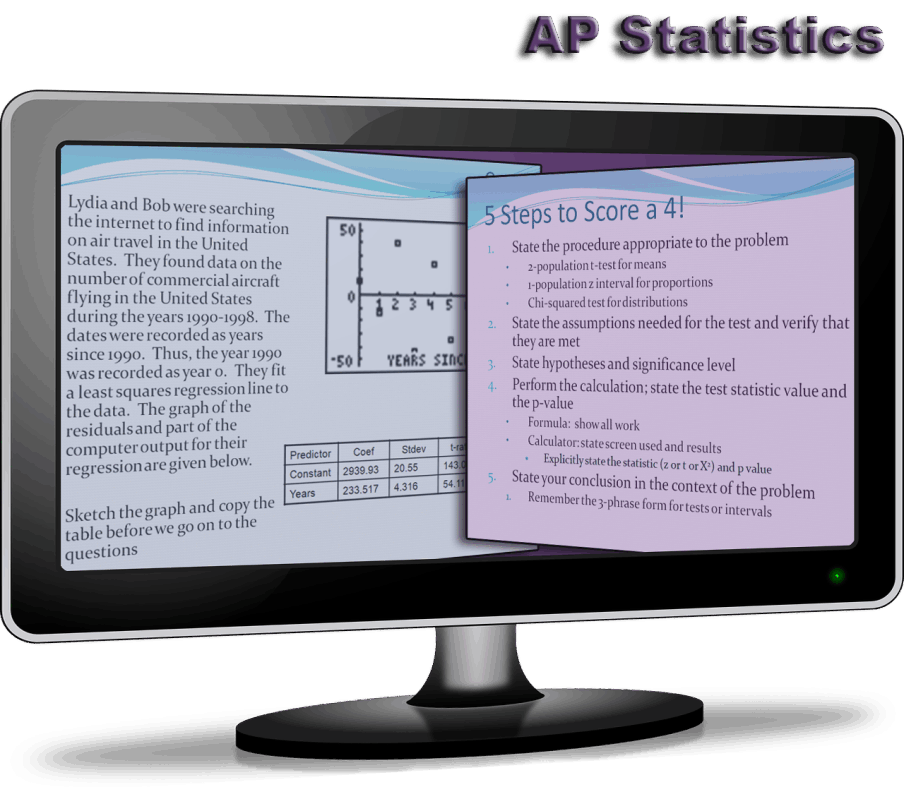Chapter 1: Exploring Data
Section 1.1: Displaying Distributions with Graphs
70111: Describing Distributions Visually
70112: More Visual Displays of Data
Section 1.2: Describing Distributions with Numbers
70121: Measures of Center and Spread
70122: Standard Deviation
Chapter 2: The Normal Distributions
Section 2.1: Density Curves and the Normal Distributions
70211: Density Curves
70212: Normal Distributions
Section 2.2: Standard Normal Calculations
70221: The Standard Normal Distribution
70222: Assessing Normality
70290: Unit 1 Review
Chapter 3: Relationships in Two-Variable Data
Section 3.1: Scatterplots
70311: Bivariate (two-variables) Scatterplots
70312: Categorical Variables in Scatterplots
Section 3.2: Correlation
70321: The Correlation Constant
Section 3.3: Least Squares Regression
70331: Linear Regression
70332: The Coefficient of Determination: r2
70333: Residuals and Residual Plots
Chapter 4: Nonlinear Two-Variable Data
Section 4.1: Modeling Nonlinear Data
70411: Exponential Regression
70412: Exponential Regression Practice
70413: Polynomial Regression
70414: Polynomial Regression Practice
70415: Regression Overview
Section 4.2: Interpreting Correlation and Regression
70421: Interpreting Correlation and Regression
Section 4.3: Relations in Categorical Data
70431: Associations in Categorical Data
70432: Simpson’s Paradox
70490: Unit 2 Review
Chapter 5: Producing Data
Section 5.1: Designing Samples
70511: Simple Random Samples
70512: Other Sampling Designs
70513: Sampling Activity
Section: 5.2: Designing Experiments
70521: Designing Experiments
70522: Three Principles of Experimental Design
70523: Block Design and Matched Pairs Design
Section: 5.3: Simulating Experiments
70531: Simulating Studies
70532: Simulating Experiments on the TI
Chapter 6: Probability
Section 6.0: Counting Theory
70601: Counting Theory (Permutation and Combination)
Section 6.1: Random Outcomes
70611: Randomness and Probability
Section 6.2: Probability Models
70621: Probability Basics
70622: Independent Events
70623: The Birthday Problem
70624: Permutation and Combination
Section 6.3: Conditional Probability
70631: Conditional Probability
70632: False Positives and Sensitive Surveys
70690: Unit 3 Review
Chapter 7: Random Variables
Section 7.1: Discrete and Continuous Random Variables
70711: Discrete Random Variables
70712: Continuous Random Variables
70713: Random Variables Work Day
Section 7.2: Means and Variances of Random Variables
70721: The Mean of a Discrete Random Variable
70722: The Variance of Random Variables
70723: Combining Two Random Variables: Means and Variances
70724: Random Variables Practice
Chapter 8: Binomial and Geometric Distributions
Section 8.1: The Binomial Distribution
70811: Binomial Probability
70812: Binomial PDF and CDF
70813: Simulations: Mean and Standard Deviation of Binomials
70814: Binomial Distribution Practice
Section 8.2: The Geometric Distribution
70821: The Geometric Distribution
70822: The Expected Value of Geometric Distributions
70890: Unit 4 Review
Chapter 9: Sampling Distributions
Section 9.1: Sampling Distributions
70911: Sampling Distributions
70912: Describing Sampling Distributions
Section 9.2: Sample Proportions
70921: Sample Proportions
Section 9.3: Sample Means
70931: Sample Means
70932: The Central Limit Theorem
70933: Chapter 9 Review- Work Day 9
Chapter 10: Introduction to Inference
Section 10.1: Confidence Intervals
71011: Statistical Confidence
71012: General Confidence Intervals
71013: Choosing Sample Size
71014: Section 10.1 Review- Workday 10.1
Section 10.2: Hypotheses & Significance Test
71021: Significance Tests
71022: Statistical Significance and Alpha Level
71023: The z Test Statistic & Two-sided Tests
71024: Section 10.2 Review- Workday 10.2
Section 10.3: Using Significance Tests
71031: Choosing Significance Level
Section 10.4: Making Decisions from Inference
71041: Type I and Type II Errors
71042: The POWER of a Hypothesis Test
71043: Section 10.4 Review- Workday 10.4
71090: Unit 5 Review
Chapter 11: Inference for Population Means
Section 11.1: One-Sample Means
71111: Applied Inference
71112: t Confidence Intervals & Tests
71113: Matched Pairs t Procedures
71114: The assumptions of a t-test and the power of a t-test
71115: Review- Workday 11.1
Section 11.2: Two-Sample Means
71121: Comparing Two Populations
71122: Two-sample tests on the TI
Chapter 12: Inference for Population Proportions
Section 12.1: One-Sample Proportions
71211: Inference for Proportions
71212: Minimum Sample Size & Proportions on TI
Section 12.2: Two-Sample Proportions
71221: Two-Sample Proportions
71222: Chapter 12 Review- Work Day 12
Chapter 13: Inference for Tables
Section 13.1: Test for Goodness of Fit
71311: The Great M&Ms Mystery
71312: Testing Distributions
71313: Simulating a Distribution
Section 13.2: Inference for Two-Way Tables
71321: Comparing Proportions for Multiple Populations
71322: Testing Associations in Categorical Variables
71323: Dice Day
Chapter 14: Inference for Regression
Section 14.1: Inference about the Model
71411: Inference for Regression
71412: Confidence Intervals & Hypothesis Tests for Regression
Section 14.3: Checking Assumptions
71431: Regression Assumptions
Activities and Review
71490: Unit 6 Review
71511: The F Distributions
71610: The Time Value of Money
71620: The Principles of Investing
71630: Practical Investing Strategies

